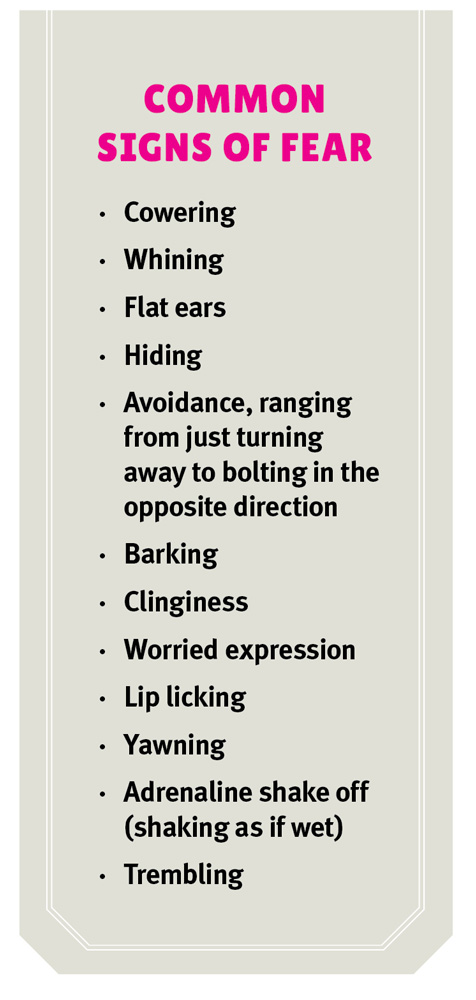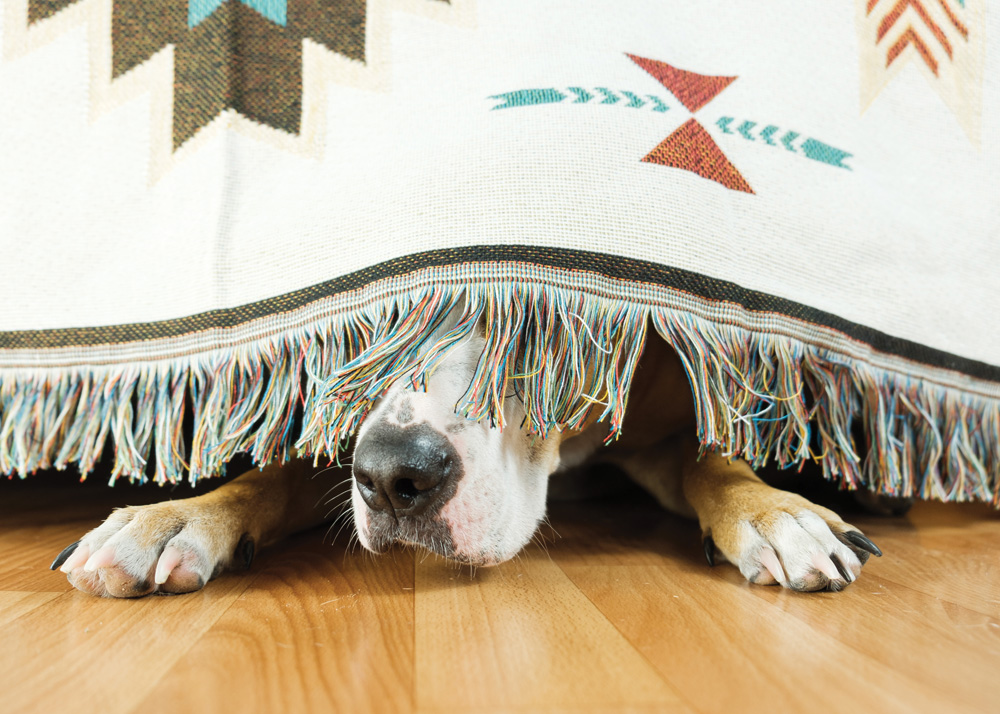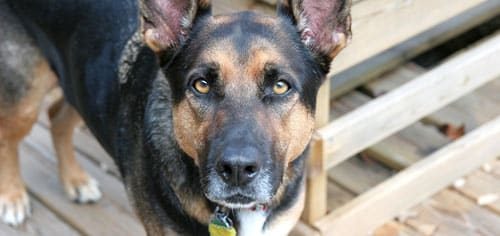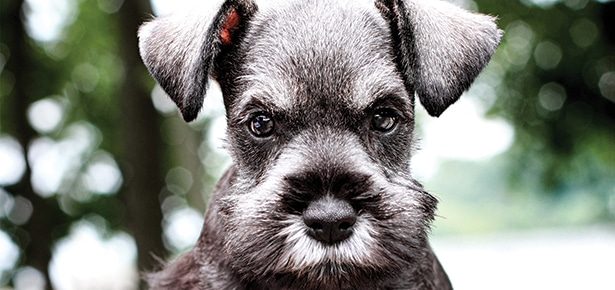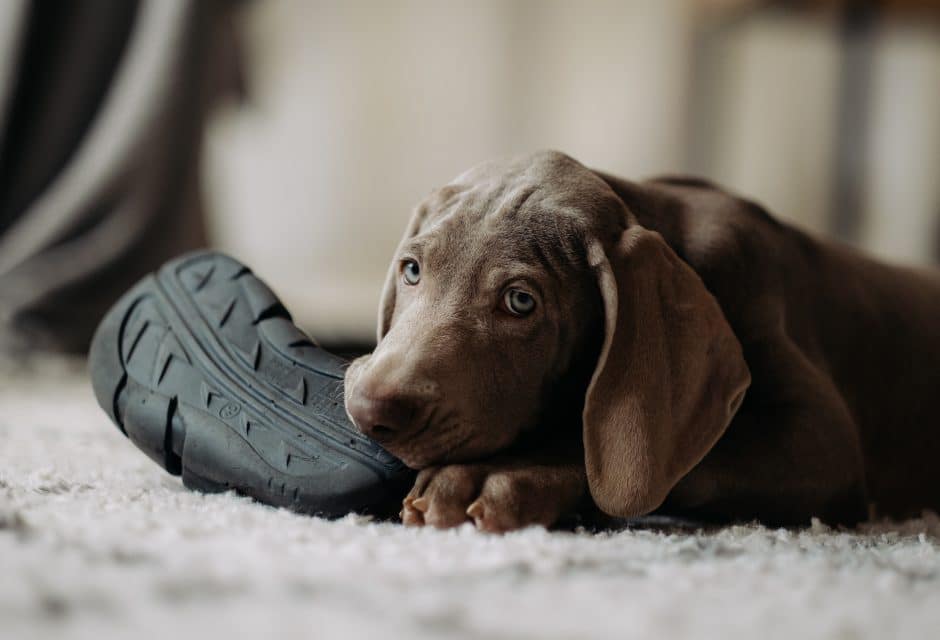
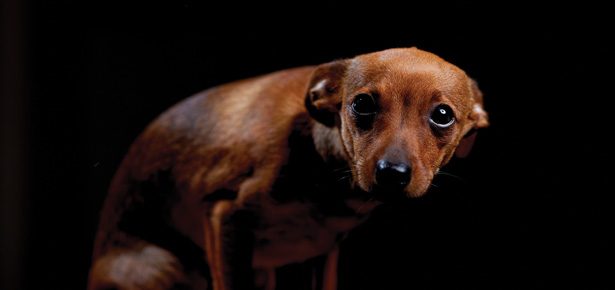
What to do About a Fearful Dog
How to deal with a dog that is scared
Sure, to you, they look like delivery folks, vacuum cleaners, and kids on skateboards. But your dog is convinced they may be potential serial killers, demons, and monsters. Don’t you wish you could just tell him everything is okay? If only it worked that way. Fear is not rational. Some fears are easy to slay, but others may take years to overcome—and your reaction will have a big impact on whether your dog thinks there’s something to worry about. So, how should you help a fearful dog? Should you comfort a dog that is scared? Read on to find out…
First off, is your dog afraid? Some signs of fear are more subtle:
• Balking. For example, your puppy refuses to walk in your neighbourhood. You may think she’s tired or walking far is too hard for her yet, but in many cases, she is simply afraid of the environment and doesn’t want to continue forward.
• Shutting down. Just because your dog is well behaved doesn’t mean he’s okay. He could be suppressed. For example, a young dog is super calm and sedate during a veterinary visit, but during subsequent visits, he growls or snaps. He may not have been okay the first visit, either. Look for changes in his demeanor. Is he always laid back and calm? If yes, then he’s probably not stressed. Is he normally bouncy and inquisitive, but now isn’t acting that way? It’s likely fear.
• Sleeping, especially in puppies. These dogs are also shutting down. It’s one thing if it’s midnight and your puppy is ready for bed. Ask yourself: what is the context? Is she surrounded by new people? Is she at a department store for socialization? A confident puppy will be inquisitive and interested in new surroundings. If your puppy is falling asleep in new places, she could be shutting down.
• Growling, barking, lunging. Most aggression is based in fear. A dog that barks, lunges, and growls at people or dogs is typically afraid of them. He is trying to put on a good front and be scary, so he can frighten away what frightens him. Some pet parents mistake this for the dog protecting them. How can you tell? If you weren’t in the picture, would your dog still bark and lunge at people or other dogs? Then he isn’t protecting you. He’s protecting himself. He would gladly throw you in front of the monster to save himself!
If you’re not sure if your dog is afraid, think about what your dog looks like when he greets you. He is probably curvy and bouncy, with squinty eyes. His tail will wag rapidly, maybe at mid-level. Keep that picture in your mind. Now, look at your dog in different situations. Does he look the same? How does he look when he greets strangers, or another dog? When you take him out to different places? If he doesn’t look the same as when he sees you, then he could be afraid.
Identifying the Monster
The next step is determining what is causing your dog’s anxiety or fear. Sometimes, this is easy. You turn on the vacuum cleaner, and your dog bolts under the bed; the vacuum cleaner is clearly evil. Your dog hesitates when greeting new people; he thinks strangers are dangerous.
Sometimes, it’s hard to tell what is causing the fear. Your dog stops during a walk and stares into space. You can’t determine what he’s looking at that could be the problem. Try listening. Is there a dog barking from behind a fence or in a house? Did a plane just pass overhead? Do you hear a lawnmower in the distance? Your dog may be frightened of sounds.
Do your best to identify the monsters so you can teach your dog not to be afraid of them.
Slaying the Monsters
Once you identify your dog’s triggers, you need to change your dog’s opinion of them.
Desensitization – gradually introduce your dog to the monster at a distance where your dog doesn’t react. As he grows more comfortable in the monster’s presence, you slowly and systematically get closer to the monster.
Counter conditioning – change your dog’s emotional response to the monster. The monster is terrifying, but cheese is delicious. If every time he looks at the monster, you give him a piece of cheese, he will start to associate the monster with cheese. Monsters gain popularity!
It’s important when working on these behaviour modification techniques that you keep your dog under threshold. This is the distance where he notices the monster but before he panics or reacts. If you keep pushing that boundary so that your dog has a reactive episode, you will not see success.
You also want to make sure you don’t flood your dog by putting him in the monster’s den. For example, if your dog is scared of other dogs, don’t take him to a dog park. You can’t control thresholds in a dog park and this scenario is likely to overwhelm him, which will not fix his fear. Instead, work on desensitization and counter conditioning. Start at a threshold where your dog notices other dogs, but before he reacts. Every time he looks at the dog in the distance, mark (click or a verbal “yes”) and treat. Repeat every time he looks at the other dog until the other dog is out of sight. When the monster leaves the picture, the treats stop coming. If your dog will not take treats even if he is not barking and lunging, then he is still over the threshold. Work farther away from his trigger.
Photo photoboyko/bigstock.com
Should You Comfort a Scared Dog?
In the past, experts would tell you not to comfort a frightened dog. The theory was that this would reinforce the behaviour, so your dog would act afraid because you praised him when he acted that way. This is not consistent with current practice because fear is not a behaviour, it’s an emotion.
If your best friend came to you in tears and afraid because she got a terrible health diagnosis, would you ignore her? If you gave her attention during this terrible crisis, would you just be indulging her and encouraging her to seek attention? Of course not. You would be there for your friend.
If your dog is afraid, you need to be present for him. Don’t go over the top with your attention, or you’ll convince him something really is wrong. Instead, just stay near him. If he’s trying to climb up your leg to get away from something frightening, go ahead and pick him up. He trusts you to take care of him. Don’t panic yourself, and don’t repeat, “It’s okay! It’s okay! It’s okay!” Just soothe him quietly and calmly.
When he is brave, really lay on the attention! Make a huge fuss over him and tell him he’s the bravest warrior ever. Be a safe harbor for him while you encourage him to slay his demons.
As always, if you need help battling monsters, call in a professional, reward-based trainer who has experience in helping dogs with anxiety and fear. You may also want to consult your veterinarian to see if behavioural medication may help. Facing fear head on can be challenging, but there is hope! Help your dog learn that the monsters he fears are not so scary
after all.
This article originally appeared in the award-winning Modern Dog magazine. Subscribe today!
Join the newsletter and never miss out on dog content again!
"*" indicates required fields
By clicking the arrow, you agree to our web Terms of Use and Privacy & Cookie Policy. Easy unsubscribe links are provided in every email.
